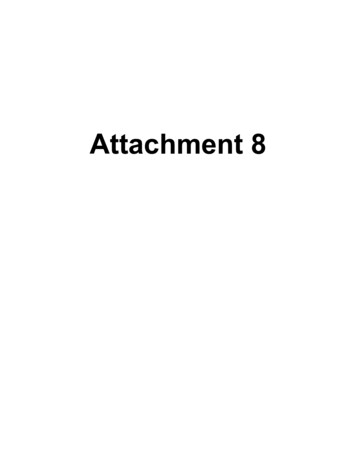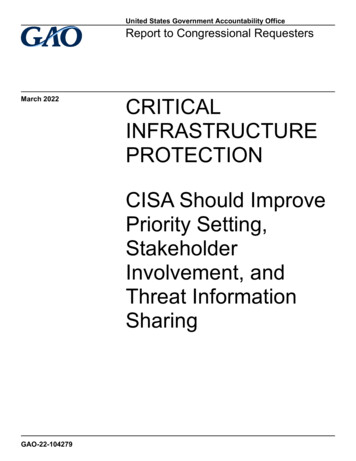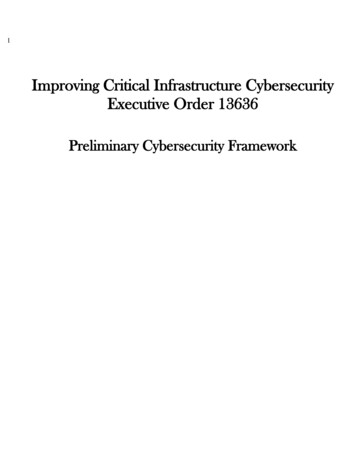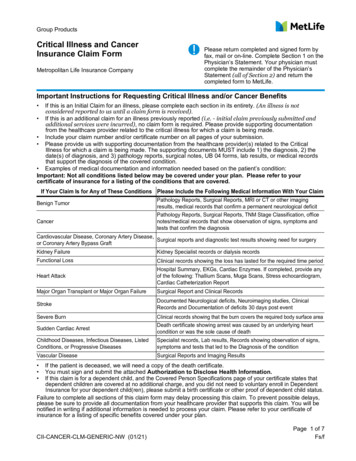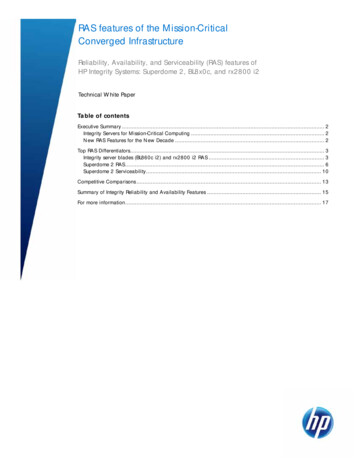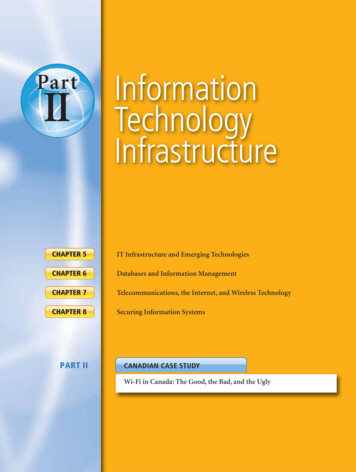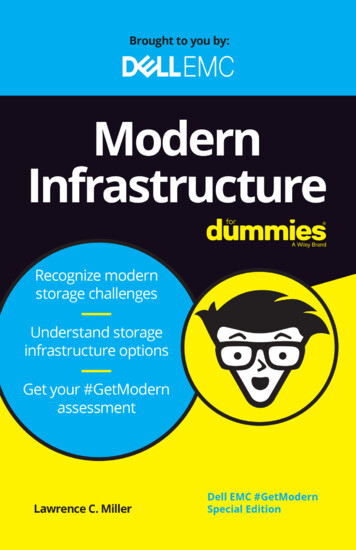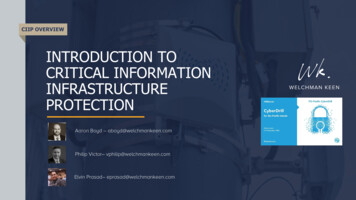
Transcription
CIIP OVERVIEWINTRODUCTION TOCRITICAL INFORMATIONINFRASTRUCTUREPROTECTION
ABOUT USTECHNOLOGY POLICYWELCHMAN KEEN IS ASTRATEGIC ADVISORY As a part of our focus on connectivity, we provide training on avariety of topics. Help to build a country’s CII strategy from the ground up through ameasured approach to include what is necessary in achieving theirspecific objectives. Our key focus on critical information infrastructure (CII) represents abelief that these pillars hold the key to national, economic, publicsafety and social well-being.TELECOMMUNICATION INVESTMENT STRATEGYCYBER RISK AND POLICY
AGENDA Introduction to critical infrastructure (CI) & Critical InformationInfrastructure (CII) Define and describe the importance of ensuring the security andresiliency of critical information infrastructure Understanding and defining critical sectors in the country Breakout session 1 – Group discussion Critical infrastructure status in Pacific Island countries Critical infrastructure sectors identification Niche sectors identification (during pandemic?) Challenges to identify critical sectors
AGENDA Identifying roles and responsibilities in managing the protection ofcritical information infrastructure within the government and sectorspecific agencies Threats and attacks on critical information infrastructure Breakout session 2 – Group discussion Identification of roles and responsibilities – Government, industry& agencies Collaboration and information sharing between government andcritical infrastructure Computer Emergency Response Team (CERT) Strategies to address cyber threats for the protection of criticalinformation infrastructure Conclusion
SECTION 01INTRODUCTION TO CRITICALINFRASTRUCTURE (CI) ANDCRITICAL INFORMATIONINFRASTRUCTURE (CII)?
Critical Infrastructure“Those infrastructureswhich are essential for themaintenance of vital societalfunctions, health, safety,security, economic or socialwell-being of people, and thedisruption or destruction ofwhich would have seriousconsequences.”SOURCE:Global Forum on Cyber Expertise (GFCE)
Critical Information Infrastructure (CII)“Material and digital assets,networks, services, andinstallations that, if disruptedor destroyed, would have aserious impact on the health,security, or economic wellbeing of citizens and theefficient function of a country’sgovernment.”SOURCE:INTERNATIONAL CIIP HANDBOOK 2008/2009
CNIICNI & CNIIIntegration
CNI FOCUSOECD 2015 Security RiskRecommendation: CNI should focus on the protection of essentialservices against digital security risk rather thanthe protection of critical informationinfrastructures themselves.
SECTION 02SECURITY AND RESILIENCY OFCRITICAL INFORMATIONINFRASTRUCTURE
CII SECURITYIMPORTANCE OF CIISECURITY Critical Information Infrastructure plays a vital role for the well-functioning ofsociety and economy A cyber attack or an outage affecting these infrastructures could have cascadingeffects on large part of the population Cyberattacks on critical infrastructure have become increasingly more complexand more disruptive, causing systems to shut-down, disrupting operations, orsimply enabling attackers to remotely control affected systems Traditionally, control systems were segregated from the open internet as theywere deployed on air-gapped networks and under tight physical security Eliminating air-gap security in favour of improving efficiency and cutting downcosts has opened critical infrastructures to threats and cyberattacks
CII SECURITYIMPORTANCE OF CIISECURITY Smart sensors and communication technologies bundled into various industrialcontrol systems expose infrastructures and organizations to risks. (IoT) Cyberattacks on critical infrastructures can have a significant economic impact,especially when targeted in conflict between nations Securing these systems is not a matter of fully reverting to physical access, but amatter of understanding how internet-connected control systems work, how theyare configured, and how they are accessed Visibility and management is key in beefing up security, but security and ITprofessionals must be aware of the risks and set-in place security controls aimedat reducing the impact of a potential cyberattack and increasing the cost of attackfor threat actors
SECTION 03IDENTIFYING AND DEFININGCRITICAL SECTORS
EXAMPLESCRITICAL SECTORS DEPENDENCIES - EXAMPLESHYOGOKEN-NANBU EARTHQUAKE (KOBE, JAPAN)HURRICANE KATRINA (UNITED STATES)The Hyogoken-Nanbu earthquake that struck Kobe, Japan andsurrounding areas on January 17, 1995.The earthquake resultedin more than 6000 deaths and 30,000injuries, and accounted foran estimated economic loss of US 200billion. Trains were derailedand a power failure left approximately one million people withoutelectricityAnother example is the 2005 Hurricane Katrina in the UnitedStates, which caused severe floods and critical infrastructurecollapse that completely paralyzed New Orleans, Louisiana andseverely affected several Gulf Coast statesPOWER GRID FAILURES (INDIA)In July 2012, several power grids failed in India, resulting inpower blackouts in most of the northern and north-eastern states.The blackouts and their crippling effects on the other criticalinfrastructures affected the lives of approximately six hundredmillion people
CI SECTORSOverarching Notion:A disruption will have severeconsequences on socio-economicwell-being and public safety,including national security
CI SECTORSCNII SECTORS A critical sector in one country may not be critical to another,however, there are common sectors that most countries agreeon to be categorised as critical and essential. Governments must prioritize these sectors when it comes to itsprotection as it relies on the availability of funding, technologyand human capacity.
SECTION 04BREAKOUT SESSION 1 –GROUP DISCUSSION
QUESTIONS Has your country identified itscritical sectors? If yes, what arethese sectors and are there anyniche sectors? Were there any new sectorsidentified during the recentpandemic? Discuss What are the challenges faced inidentifying critical sectors?(especially for countries that havenot identified these sectors)
SECTION 05IDENTIFYING ROLES ANDRESPONSIBILITIES INMANAGING CRITICALINFORMATION INFRASTRUCTURE
PROTECTING CIIPROTECTING CII – ROLES ANDRESPONSIBILITIES Protecting critical infrastructure against growing andevolving cyber threats requires a layered approach. Build and grow the cyber workforce to ensure sufficientskills and talent is available Government must actively collaborate with the publicand private sector partners to improve the security andresilience of critical infrastructure National Computer Emergency Response Teams(CERT) must respond to and mitigate the impacts ofattempted disruptions to the nation’s critical cyber andcommunications networks and to reduce adverseimpacts on critical network systems Information sharing and collaboration platform is vitalbetween public-private CII
PROTECTING CIIPROTECTING CII –CERT/CIRTA CERT/CIRT is an organisation or team that provides, to a well-defined constituency, services and support for bothpreventing and responding to computer security incidentsObjectives of incident response: To mitigate or reduce risks associated to an incident To respond to all incidents and suspected incidentsbased on pre-determined process Provide unbiased investigations on all incidents Establish a 24x7 hotline/contact – to enable effectivereporting of incidents. Control and contain an incident Affected systems return to normal operation Recommend solutions – short-term and long-term solutions
SECTION 06THREATS ANDATTACKS ON CNIICybersecurity
THREATS DURING COVID-19INCREASED CYBERTHREATS DURING COVID-19 Recent assessment conducted by INTERPOL, it was revealedthat the Covid-19 pandemic has seen a shift of attacks fromsmall businesses to critical infrastructure, government and majorcorporations. Deloitte reported that COVID-19 is seeing a “next normal” wheresectors not classified as critical before are now being viewed ascritical. Healthcare and humanitarian organisations such as WHO arebeing targeted and Check Point Software Technologies reporteda 500% increase in attacks toward these organisations. Hackers targeting companies critical to the distribution of Covid19 vaccines. “A global phishing campaign" focused onorganisations associated with the Covid-19 vaccine "cold chain“– IBM, Dec 3, 2020
THREATS AND ATTACKSMOST TARGETED INDUSTRIES (CNII) - al Statistics512111064042211
GlobalCNIICyberAttacks2009 - 202025
CNIICyberAttacksEnergy & Power Grid(1982 – 2020)26
CNIICyberAttacksTransportation(1997 – 2020)27
CNIICyberAttacksFinancial(2010 – 2020)28
THREATS AND ATTACKSCNII CYBER ATTACK Phishing: Spearphishing, Whaling, Smishing, Voice phishingBaiting TrojanSpywareKeyloggerRansomware
CNIICYBERATTACKSRansomware(1989 – 2020)30
SECTION 07BREAKOUT SESSION 2 –GROUP DISCUSSION
QUESTIONS Who is “in charge” of critical infrastructuresecurity and resilience nationally,regionally, locally, and across the criticalsectors? How do the various government andprivate entities with critical infrastructuresecurity and resilience responsibilities atdifferent levels interact and collaboratewith one another? Does your country have a NationalCERT/CIRT? If no, do you plan to establishone or face any challenges in establishingit?
Section 08STRATEGIES IN ADDRESSINGTHE THREATSCIIP
CII PROTECTIONCIIP for Operators Define a risk management frameworkBuild and test emergency plansTraining and educationSupply chain securityInformation sharing and cooperationLegal complianceContinuous monitoring and assessment ofcybersecurity posture
CIIP FOR OPERATORSCIIP FOR OPERATORSDefine a riskmanagementframework Elaborates a continuous and repeatable methodology for identifying, assessing, and responding tocybersecurity risks. (e.g. NIST framework)Build and testemergency plans Plans must involve both physical and cyber-attacks to the infrastructure and include the process to defend,mitigate and respond against it. Organisations can determine their risk tolerance, thus the acceptable level of risk for achieving their supplyand organisational goals and are able prioritize remediations and make informed decisions aboutcybersecurity investments On the national level, the national cybersecurity agency will periodically organise a cyber exercise to simulatepotential attack vectors against the CII. This allows the CII to prepare for such attacks better and designappropriate responses to protect, defend and mitigate those threats.
CIIP FOR OPERATORSCIIP FOR OPERATORSTraining, awareness& education Training is to equip individuals with the necessary skills to perform specific functions within the organisationSupply chainsecurity Due to extensive outsourcing, today’s supply chain is increasingly complex and externalized, withsubsequent additional risks. Employees must be made aware of the information security policies and the importance of adhering to it.Communicating this to all employees is vital to ensure they know, understand and obey. The key outcome ofsecurity awareness programs and activities is to create a culture of security, change of behaviour and attitude. The resilience of a supply chain depends on its weakest link and operators are secure only if their entireecosystem of partners and vendors is secure. Adversaries can use poorly protected partners as attack vectors to compromise critical operators. An integrated and sustainable supply chain security objective must be included in business plans, contractsand operations
CIIP FOR OPERATORSCIIP FOR OPERATORSInformation sharing& cooperation Through information sharing, CII can reduce and prevent the spread of the attack and minimise the damage tothe infrastructure and country. Through partnerships, sectors can share information as well as collaborate to solve issues relating tocybersecurity threats and attacks. Alliances also help to share skills within the sectors where some unique skills may be required from thegovernment or private sector. (e.g. FIRST)Legal compliance Legal compliance ensure that operators meet critical security standards identified by national decision makers.Continuousmonitoring &assessment ofcybersecurityposture Digital risk landscape is in constant evolution and need to build repeatable processes to monitor and assess thecybersecurity maturity level on an ongoing basis Assessment should consider the risk-related adequacy of the processes, people, and technology, in order toidentify cybersecurity substantial gaps and determine appropriate remedies to resolve weaknesses CNI must examine the general preparedness of the operator, and the ability to detect and to respond to incidentsand ensure business continuity
CIIP FOR COUNTRIESCIIP for Countries
Section 09CONCLUSION &MOVING FORWARDCNII Protection
MOVING FORWARDCNII must have: A shift of mindset inthe mannercybersecurity isaddressed. Look beyond technicaltools to adopt a newcyber defence strategy
CONCLUSIONCONCLUSION Be prepared – training & vulnerability assessment Design sector specific resources & initiatives Cooperate with agencies on a national, regional and internationallevel Expand information sharing and collaboration Build robust national policies & strategies
WK Capacity Building RoadmapIntroduction to CriticalNational InformationInfrastructure Protection –Awareness ProgramCritical NationalInformationInfrastructureProtection WorkshopRisk Based Approachfor Critical NationalInformationInfrastructure ProtectionCERTManagementWK, as ITU’s Sector Member, will conduct trainings, webinars and workshops inthe Pacific Island to enhance skills and knowledge for CII protection in 2021/2022.Current available programs are stated ertificationProgramsIn this phase, WK will focus on building technical capabilities inthe Pacific Island42
THANK YOUINTRODUCTION TOCRITICAL INFORMATIONINFRASTRUCTUREPROTECTION
Objectives of incident response: To mitigate or reduce risks associated to an incident To respond to all incidents and suspected incidents based on pre-determined process Provide unbiased investigations on all incidents D W Establish a 24x7 hotline/contact -to enable effective reporting of incidents.

